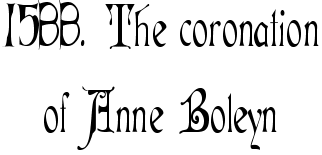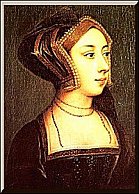|
|
||
Henry only provided coronations for his first two wives. Katharine of Aragon shared his coronation in 1509; Anne's lavish ceremony took place on 29 May 1533. She would be executed almost exactly three years later. The coronation was not a success, despite its expense. Anne was not popular. Insults were shouted; mocking laughter was heard. Anne was already two months pregnant with the future Queen Elizabeth I. This undoubtedly hastened her secret marriage and coronation. Henry VIII wanted no one to doubt the legitimacy of his son or the nobility of his parentage. |
On Thursday 29 May, Lady Anne, marquess of Pembroke, was received as queen of England by all the lords of England. And the mayor and aldermen, with all the guilds of the City of London, went to Greenwich in their barges after the best fashion, with also a barge of bachelors of the mayor's guild richly hung with cloth of gold with a great number to wait on her. And so all the lords with the mayor and all the guilds of London brought her by water from Greenwich to the Tower of London, and there the king's grace received her as she landed, and then over a thousand guns were fired at the Tower, and others were fired at Limehouse, and on other ships lying in the Thames. And on Saturday, the last day of May, she rode from the Tower of London through the City with a goodly company of lords, knights and gentlemen, with all the peers of the realm, richly appareled. She herself rode in a rich chariot covered with cloth of silver, and a rich canopy of cloth of silver borne over her head by the four Lords of the Ports, in gowns of scarlet, followed by four richly hung chariots of ladies; and also several other ladies and gentlewoman riding on horseback, all in gowns made of crimson velvet. And there were various pageant made on scaffolds in the city; and all the guilds were standing in their liveries, every one in order, the mayor and aldermen standing in Cheapside. And when she came before them the Recorder of London made a goodly presentation to her, and then the mayor gave her a purse of cloth of fold with a thousand marks of angel nobles in it, as a present from the whole of the city; and so the lords brought her to the palace of Westminster and left her there that night. On 1 June Queen Anne was brought from Westminster Hall to St Peter's Abbey in procession, with all the monks of Westminster going in rich copes of gold, with thirteen mitred abbots; and after them all the king's chapel in rich copes with four bishops and two mitred archbishops, and all the lords going in their parliament robes, and the crown borne before her by the duke of Suffolk, and her two sceptres by two earls, and she herself going under a rich canopy of cloth of gold, dressed in a kirtle of crimson velvet decorated with ermine, and a robe of purple velvet decorated with ermine over that, and a rich coronet with a cap of pearls and stones on her head; and the old duchess of Norfolk carrying her train in a robe of scarlet with a coronet of gold on her cap, and Lord Burgh, the queen's Chamberlain, supporting the train in the middle. After her followed ten ladies in robes of scarlet trimmed with ermine and round coronets of gold on their heads; and next after them all the queen's maids in gowns of scarlet edged with white Baltic fur. And so she was brought to St Peter's church at Westminster, and there set in her high royal seat, which was made on a high platform before the altar. And there she was anointed and crowned queen of England by the archbishop of Canterbury and the archbishop of York, and so sat, crowned, in her royal seat all through the mass, and she offered at the said mass. And when the mass was done they left, every man in his order, to Westminster Hall, she still going under the canopy, crowned, with two sceptres in her hands, my Lord Wiltshire her father, and Lord Talbot leading her, and so dined there; and there was made the most honourable feast that has been seen. The great hall at Westminster was richly hung with rich cloth of Arras, and a table was set at the upper end of the hall, going up twelve steps, where the queen dined; and a rich cloth of estate hung over her head. There were also four other tables along the hall; and it was railed on every side, from the high dais in Westminster Hall to the platform in the church in the abbey. And when she went to church to her coronation there was a striped blue cloth spread from the high dais of the king's bench to the high altar of Westminster on which she went. And when the queen's Grace had washed her hands, then came the duke
of Suffolk, high constable for that day and steward of the feast, riding
on horseback, richly dressed and decorated, and with him, also riding on
horseback, Lord William Howard as deputy for the duke of Norfolk in his
office of marshall of England, and there came the queen's service followed
by the archbishop's with a certain space between, which was all borne by
knights; the archbishop sitting at the queen's board, at the end on her
left hand. The earl of Sussex was sewer, earl of Essex carver, earl
of Derby cup bearer, earl of Arundel butler, Viscount Lisle panter, and
Lord Grey almoner.
|
|

 This
account of Anne Boleyn's coronation was written by the Tudor chronicler
Edward Hall.
This
account of Anne Boleyn's coronation was written by the Tudor chronicler
Edward Hall.